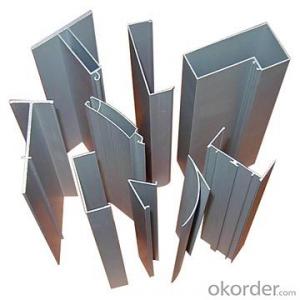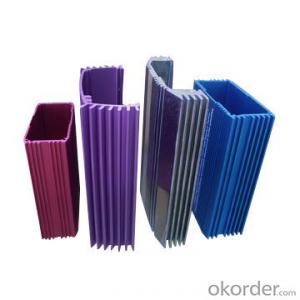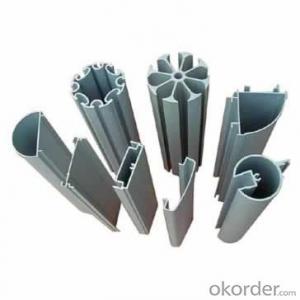Alloy 6063 T5 Extruded Frame Aluminum Profiles
- Loading Port:
- China Main Port
- Payment Terms:
- TT OR LC
- Min Order Qty:
- -
- Supply Capability:
- -
OKorder Service Pledge
Quality Product, Order Online Tracking, Timely Delivery
OKorder Financial Service
Credit Rating, Credit Services, Credit Purchasing
You Might Also Like
Material | Alloy 6063,6061,6005or according to customer’s choice |
Temper | T3, T4, T5, T6 |
Surface | Anodize, electrophoresis, powder coating, PVDF coating, wood grain painting, matted, etc. |
Color | Any colour based on Standard Germany RAL Mark |
Length | Coating 6.5 meters, Anodizing 6.5 meters, Mill finish 5 meters |
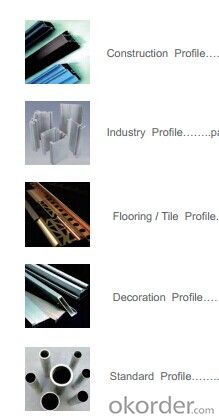

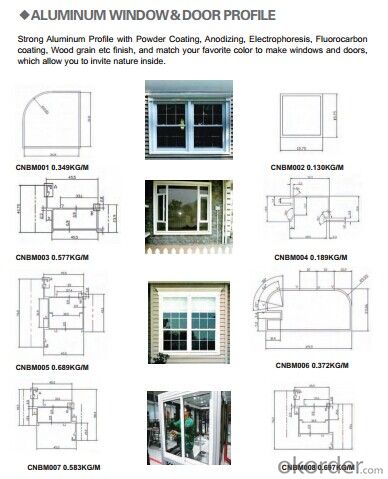
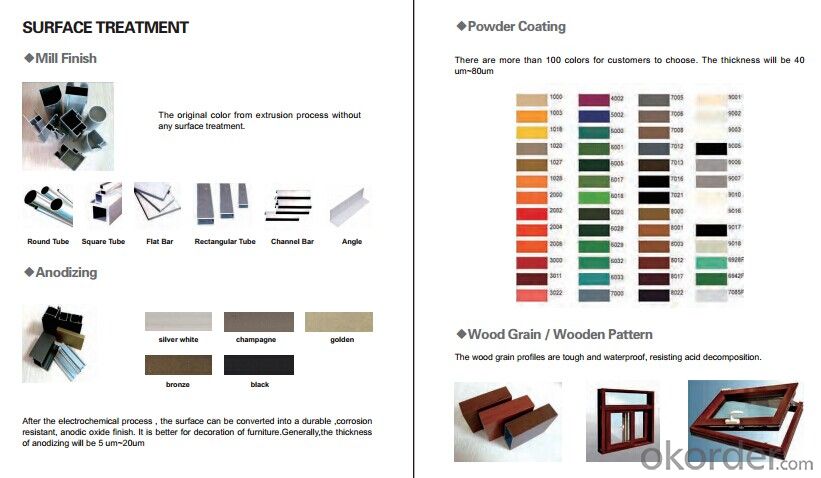
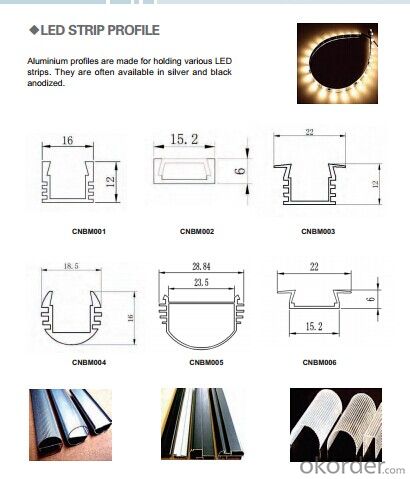
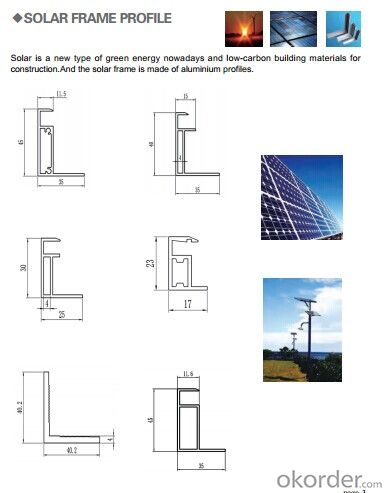
- Q:What is the difference between the type 4040c and 4040d of aluminum profile?
- I think you see two things and find it makes no difference to ask the question! If so, the two profiles are identical, just numbers from different companies!
- Q:How about the weight calculation of 180 series semi concealed curtain wall aluminum profile
- A section of properties in CAD labeled dynamic block, the section area and mark block association graph can be easily calculated, section area, surface area, weight theory, and the setting up of a variety of materials such as aluminum options.
- Q:Can aluminum profiles be used in automotive applications?
- Yes, aluminum profiles can be used in automotive applications. Aluminum profiles are lightweight, strong, and corrosion-resistant, making them suitable for various automotive components such as body panels, chassis parts, and engine components. Their use helps reduce the overall weight of the vehicle, improving fuel efficiency and performance.
- Q:Does aluminum alloy profile conduct electricity?
- Aluminum conducts well, and aluminium alloys must also be electrically conductive. But aluminum alloys contain impurities such as silicon and magnesium
- Q:What are the dimensions of standard aluminum profiles?
- The dimensions of standard aluminum profiles can vary depending on the specific profile and its intended use. However, common dimensions for standard aluminum profiles typically range from a few millimeters to several inches in width and height, with lengths varying based on the manufacturer's specifications.
- Q:Aluminum bending or curling
- We focus on the technology that customers really need and provide long-term solutions to help customers make the best quality products at an efficient and low cost.We can provide:- bending technical consulting- material selection assistance- professional equipment selection assistance- assistance in vendor selection- bargaining help- personal training for technical personnel;- optimal solution
- Q:What are the load-bearing capacities of aluminum profiles?
- Several factors, including profile design, dimensions, material grade, and intended application, contribute to the varying load-bearing capacities of aluminum profiles. Due to their excellent strength-to-weight ratio, aluminum profiles find wide application across various industries. However, it is crucial to seek advice from the manufacturer or an engineer to obtain precise load-bearing capacity information. Typically, aluminum profiles are engineered to withstand different types of loads, namely static, dynamic, and impact loads. Static loads refer to constant weights or forces over time, while dynamic loads involve moving or changing forces. On the other hand, impact loads result from collisions or sudden changes in motion. Engineers determine the load-bearing capacity of an aluminum profile by considering its maximum allowable deflection, bending moment, shear force, and torsional stress before failure. These calculations involve the analysis of the profile's geometry, cross-sectional properties, and material properties. It is important to note that load-bearing capacities can be influenced by factors such as temperature, corrosion, surface treatment, and the presence of additional components or attachments. Therefore, it is essential to consider these factors and refer to the manufacturer's specifications or engineering guidelines for safe and reliable load-bearing capabilities. In conclusion, the load-bearing capacities of aluminum profiles are influenced by multiple factors and can vary significantly. To determine the specific load-bearing capacity for a particular aluminum profile in a given application, it is advisable to consult with manufacturers, engineers, or industry standards.
- Q:What are the advantages of using aluminum profiles in the renewable energy sector?
- There are several advantages of using aluminum profiles in the renewable energy sector. Firstly, aluminum is lightweight and provides high strength, making it ideal for constructing solar panels and wind turbines. This allows for easier installation and transportation, reducing costs and increasing efficiency. Additionally, aluminum is highly corrosion resistant, ensuring the longevity and durability of renewable energy systems. Aluminum profiles also offer flexibility in design, allowing for customization and adaptation to various project requirements. Finally, aluminum is a sustainable and recyclable material, aligning with the eco-friendly nature of the renewable energy sector. Overall, the use of aluminum profiles in the renewable energy sector offers numerous benefits in terms of cost-effectiveness, performance, and environmental sustainability.
- Q:What is the relationship between aluminum alloy and aluminum alloy?
- First, according to use can be divided into the following categories: 1. building doors and windows, aluminum doors and windows [1] (divided into two windows and curtain walls). Special aluminum radiator 2. CPU radiator 3. Aluminum Alloy shelf aluminum profile, the difference between them is that the different cross-sectional shapes. They are produced by hot melt extrusion 4.. Industrial aluminum: mainly used in automation equipment, sealing cover skeleton and the custom mold machinery and equipment according to their own requirements, such as assembly line conveyor belt, hoisting machine, glue machine, testing equipment, electronic machinery industry and clean room with the majority!
- Q:What are the different types of surface protection for aluminum profiles?
- There are several types of surface protection for aluminum profiles, including anodizing, powder coating, painting, and laminating. Anodizing involves creating a durable oxide layer on the surface of the aluminum, providing corrosion and wear resistance. Powder coating involves applying a dry powder to the surface and then curing it with heat, creating a tough and decorative finish. Painting involves applying liquid paint to the surface, providing both protection and aesthetic appeal. Laminating involves applying a layer of protective film or sheet to the surface, offering scratch resistance and added durability.
1. Manufacturer Overview |
|
|---|---|
| Location | |
| Year Established | |
| Annual Output Value | |
| Main Markets | |
| Company Certifications | |
2. Manufacturer Certificates |
|
|---|---|
| a) Certification Name | |
| Range | |
| Reference | |
| Validity Period | |
3. Manufacturer Capability |
|
|---|---|
| a)Trade Capacity | |
| Nearest Port | |
| Export Percentage | |
| No.of Employees in Trade Department | |
| Language Spoken: | |
| b)Factory Information | |
| Factory Size: | |
| No. of Production Lines | |
| Contract Manufacturing | |
| Product Price Range | |
Send your message to us
Alloy 6063 T5 Extruded Frame Aluminum Profiles
- Loading Port:
- China Main Port
- Payment Terms:
- TT OR LC
- Min Order Qty:
- -
- Supply Capability:
- -
OKorder Service Pledge
Quality Product, Order Online Tracking, Timely Delivery
OKorder Financial Service
Credit Rating, Credit Services, Credit Purchasing
Similar products
New products
Hot products
Hot Searches
Related keywords
